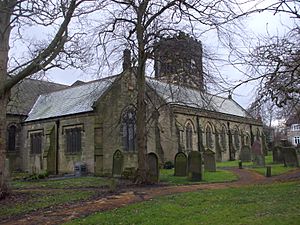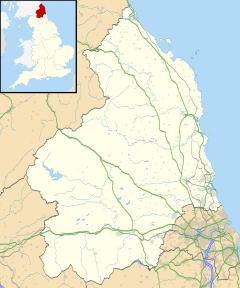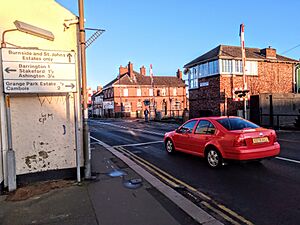Bedlington facts for kids
Quick facts for kids Bedlington |
|
|---|---|
 St. Cuthbert's Church, Bedlington |
|
| Population | 18,470 |
| OS grid reference | NZ258819 |
| Civil parish |
|
| Unitary authority |
|
| Ceremonial county | |
| Region | |
| Country | England |
| Sovereign state | United Kingdom |
| Post town | BEDLINGTON |
| Postcode district | NE22 |
| Dialling code | 01670 |
| Police | Northumbria |
| Fire | Northumberland |
| Ambulance | North East |
| EU Parliament | North East England |
| UK Parliament |
|
Bedlington is a town in Northumberland, England. About 18,470 people lived here in 2011.
Bedlington is an old market town with a long history of industry. It is known for its creative residents. The town is about 10 miles (16 km) northeast of Newcastle upon Tyne and its airport. It's also close to the A1 road. Other nearby towns include Morpeth, Ashington, Blyth, and Cramlington.
People have lived in Bedlington since the Bronze Age. An ancient burial site was found near the main Front Street. Cist burials from the Bronze Age were discovered there in the 1930s. St Cuthbert's Church is the oldest building in town. Parts of it are from the 11th century, and it recently celebrated being 1000 years old. The church is in the middle of the old town centre, which has sandstone buildings. Many old buildings and factories have been taken down over the years. However, you can still see hints of the medieval street layout. Today, the main Front Street has buildings from the Georgian and Victorian eras.
During the Industrial Revolution, Bedlington made goods that went all over the world. For example, nails and parts for trains were made here over 250 years ago. Large industries, like iron works, came to Bedlington more than 250 years ago. Coal mining became a big part of the town's life starting in 1838. The coal industry was very important until the mines closed in the 1980s. Now, Bedlington's Front Street has many popular places to eat and drink. New shops and businesses are also opening in the town.
The area around Bedlington used to be a special part of County Durham. It was called Bedlingtonshire.
Contents
History of Bedlington
The name "Bedlington" first appeared around 1050. It was in a book about Saint Cuthbert. The name means "the town of Bedla's people."
Between 900 and 915, Cutheard, who was the Bishop of Durham, bought Bedlington and its small villages. Even though it was in Northumberland, it became part of the special area of Durham. This area was ruled by the Bishop, who had royal rights given by William the Conqueror.
In 1536, these special rights were taken from Bishop Cuthbert Tunstall. Bedlington lost its special status then. But in 1541, it was given back to him. In 1866, Bedlington became part of the church's land. Later, in 1832 and 1844, Bedlingtonshire became part of Northumberland for everyday purposes.
Bedlington grew into an industrial town. It had an iron works and many coal mines. But when these industries closed in the late 1900s, the town changed a lot. It became more of a place where people live and travel to work in other areas. In the 1970s, the council took down many homes built for mining families.
An important old building was Bedlington Old Hall. It had a 15th-century pele tower and an 18th-century stone building. It was sadly taken down in 1959. Council offices were built there instead. These offices are now empty.
The old parish of Bedlington ended on April 1, 1974. It became part of the Wansbeck area.
Town Features
The town has three large supermarkets. It also has a post office and many smaller shops.
A market is held every Thursday in the market square. However, fewer market stalls are setting up there now.
Getting Around Bedlington
Air and Sea Travel
The closest airport is Newcastle Airport. You can fly from there to many cities in Europe. There are also long-distance flights and holiday flights. A port in nearby North Shields has daily passenger services to IJmuiden in the Netherlands.
Bus Services
Arriva North East is the main bus company in Bedlington. Their buses connect Bedlington to Ashington, Morpeth, Cramlington, Blyth, Stakeford, and Newcastle. The X21/X22 bus services run often, about every 10 minutes on weekdays. They link Ashington, Guide Post, Bedlington Station, Regent Centre, Gosforth, and Newcastle Haymarket. The 2 bus service connects Morpeth, Guide Post, Bedlington Station, and Blyth.
Train Services
Work is happening now to build the Northumberland Line. This will bring back passenger train services from Ashington to Bedlington, Blyth, Seaton Delaval, Shiremoor, and Newcastle. Train services in Bedlington began operating in late 2024 or early 2025.
Roads
The A189 Spine Road is about 1.5 miles (2.4 km) east of the town centre. It connects Ashington, Blyth, Cramlington, Killingworth, Gosforth, and Newcastle. The A1 road is about 3 miles (5 km) from the town centre. This road connects to Scotland and London. Bedlington also has other important roads like the A193, A1068, A1147, and the B1331.
Schools in Bedlington
Bedlington has two secondary schools: Bedlington Academy and St Benet Biscop Catholic Academy. Both are in Bedlington. They also welcome students from nearby places like Stakeford, Guide Post, Choppington, Stannington, and parts of Morpeth.
There are three primary schools in Bedlington: Bedlington Station Primary School, Stead Lane Primary School, and St Bede's Primary School. Meadowdale Academy used to be a middle school, which is rare in England. However, it is changing to a primary school. The town also has two first schools: Whitley Memorial C of E School and Bedlington West End County First School. Whitley Memorial C of E School became a primary school in the summer of 2021. Some students might also travel about 13 miles (21 km) south to Newcastle upon Tyne for independent schools.
Local Churches and Nature
One of the most important old buildings is the Anglican church, which is named after St. Cuthbert. It is believed that on December 12, 1069, monks from Durham rested St Cuthbert's body in Bedlington Church. They were running north from the Conqueror's army. The church was first built in a Saxon style. It was rebuilt about 100 years later. Not much of the original Saxon or Norman church remains today.
There is also a Roman Catholic church called St Bede's. It is a newer building. The town also has a Salvation Army chapel.
Hartford Hall is located within the parish. Much of the land along the river between Bedlington and the hall is part of Bedlington Country Park. This park is a special local nature reserve.
Local News and Media
Local newspapers include the Evening Chronicle and The Journal. These papers also cover Tyneside and other parts of southeast Northumberland. The Newspost Leader is a weekly paper that covers most of the old Wansbeck area. The community website Bedlington.co.uk started in 1998. It has helped promote the town in many ways.
Local radio stations include BBC Radio Newcastle, Capital North East, Heart North East, Smooth North East, Hits Radio North East, and Koast Radio, which is a community station. Local TV news programs are provided by ITV News Tyne Tees and BBC Look North.
Famous People from Bedlington
- John Birkinshaw (invented wrought iron rails in 1820)
- Daniel Gooch (1816–1889) — railway and cable engineer
- John Viret Gooch (1812–1900) — railway engineer
- Thomas Longridge Gooch (1808–1882) — civil engineer
- Jayne Middlemiss (born 1971) — TV and radio presenter
- Denis Murphy (born 1948) — a politician who was a Member of Parliament
- Kenneth Pearson (born 1951) — cricketer
- Kathy Secker (1945–2015) — television presenter
- Chris Dobey (born 1990) — darts player
- Callan Rydz (born 1998) — darts player
Twin Town
Bedlington is twinned with Schalksmühle in North Rhine-Westphalia, Germany.
Nearby Towns
- Blyth
- Cramlington
- Bebside
- Stakeford
- Morpeth
- Ashington
- Guide Post
- Cambois
See also
- Bedlington Terriers FC



